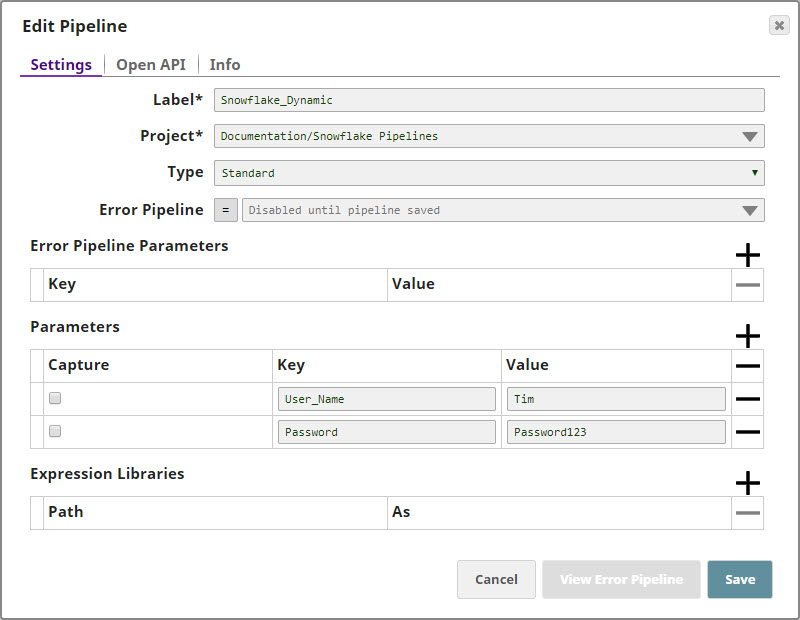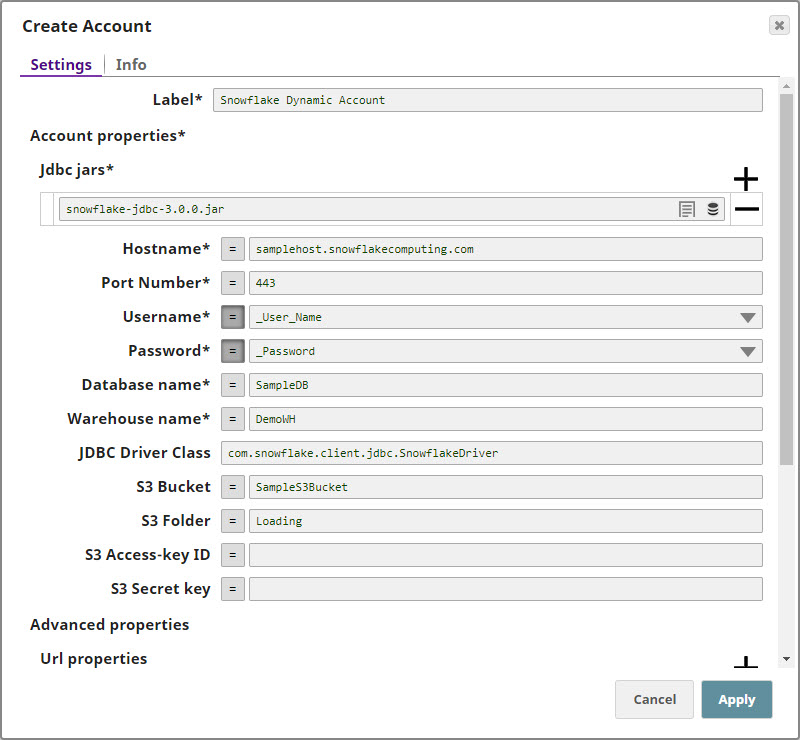On this Page
tocOn this Page
| Table of Contents | ||||||
|---|---|---|---|---|---|---|
|
This account is used by Snaps in the Snowflake Snap Pack.
You can create an account from SnapLogic Designer or Manager. In Designer, when working on pipelines, every Snap that needs an account prompts you to create a new account or use an existing account. The accounts can be created in or used from:
- Your private project folder: This folder contains the pipelines that will use the account.
- Your Project Space’s shared folder: This folder is accessible to all the users that belong to the Project Space.
- The global shared folder: This folder is accessible to all the users within an organization in the SnapLogic instance.
Account Configuration
In Manager, you can navigate to the required folder and create an account in it (see Accounts). To create an account for Snowflake:
- Click Create, then select Snowflake > Snowflake S3 Database Account or Snowflake > Snowflake S3 Dynamic Account or Snowflake Azure Database Account.
- Supply an account label.
- Supply the Account properties and Advanced properties for your Snowflake Database account. When using Snowflake S3 Dynamic Account, you can specify the Account properties as expressions referencing pipeline parameters.
- (Optional) Supply additional information on this account in the Notes field of the Info tab.
- Click Apply.
| Warning |
|---|
Avoid changing account credentials while pipelines using them are in progress. This may lead to unexpected results, including locking the account. |
| Note |
|---|
If the Snap fails to connect to the database, it will retry three more times. |
| Note |
|---|
For details on account encryption, see Using Account Encryption, below. |
Account Types
Snowflake Azure Database Account
| Expand | |||||||||||||||||||||||||||||||||||||||||||||||||||||||||||||||||||||||||||||||||||||||||||||||||||||
|---|---|---|---|---|---|---|---|---|---|---|---|---|---|---|---|---|---|---|---|---|---|---|---|---|---|---|---|---|---|---|---|---|---|---|---|---|---|---|---|---|---|---|---|---|---|---|---|---|---|---|---|---|---|---|---|---|---|---|---|---|---|---|---|---|---|---|---|---|---|---|---|---|---|---|---|---|---|---|---|---|---|---|---|---|---|---|---|---|---|---|---|---|---|---|---|---|---|---|---|---|---|
| |||||||||||||||||||||||||||||||||||||||||||||||||||||||||||||||||||||||||||||||||||||||||||||||||||||
Account Settings
| |||||||||||||||||||||||||||||||||||||||||||||||||||||||||||||||||||||||||||||||||||||||||||||||||||||
Snowflake S3 Database Account
| Expand | |||||||||||||||||||||||||||||||||||||||||||||||||||||||||||||||||||||||||||||||||||||||||||||||
|---|---|---|---|---|---|---|---|---|---|---|---|---|---|---|---|---|---|---|---|---|---|---|---|---|---|---|---|---|---|---|---|---|---|---|---|---|---|---|---|---|---|---|---|---|---|---|---|---|---|---|---|---|---|---|---|---|---|---|---|---|---|---|---|---|---|---|---|---|---|---|---|---|---|---|---|---|---|---|---|---|---|---|---|---|---|---|---|---|---|---|---|---|---|---|---|
| |||||||||||||||||||||||||||||||||||||||||||||||||||||||||||||||||||||||||||||||||||||||||||||||
| |||||||||||||||||||||||||||||||||||||||||||||||||||||||||||||||||||||||||||||||||||||||||||||||
Snowflake S3 Dynamic Account
| Expand | ||||
|---|---|---|---|---|
| Required. The name for the account. Default value: None. | |||
Account properties | Required. The information required to create a connection to the database. |
| ||
Using Pipeline Parameters in Account Configuration
You can use pipeline parameters when configuring dynamic Snowflake accounts. For information on pipeline parameters, see Pipeline Parameters in Pipeline Properties.
Example
Define the following two pipeline parameters in the pipeline with which you want to associate the new account:
- User_name
- Pass_word
You will use these values in the dynamic account.
Back in the Snowflake pipeline, create a Snowflake Dynamic Account
- Set the expression toggle on for both Username and Password
- Set Username to _user_name and Password to _password
- Click Apply and fill the Snap Settings for the desired function.
| Note |
|---|
| You cannot Validate an account connection when creating a Snowflake Dynamic Account because the account properties of a dynamic account are provided dynamically as pipeline parameters. |
Apply the changes. Your dynamic account is now configured; and your username and password details should change as you update them in your pipeline parameters.
See Also
Account History
| Expand | ||||||||||||||||||||||||||||||||||||||||||||||||||||||||||||||||||||||||||||||||||||||
|---|---|---|---|---|---|---|---|---|---|---|---|---|---|---|---|---|---|---|---|---|---|---|---|---|---|---|---|---|---|---|---|---|---|---|---|---|---|---|---|---|---|---|---|---|---|---|---|---|---|---|---|---|---|---|---|---|---|---|---|---|---|---|---|---|---|---|---|---|---|---|---|---|---|---|---|---|---|---|---|---|---|---|---|---|---|---|
| ||||||||||||||||||||||||||||||||||||||||||||||||||||||||||||||||||||||||||||||||||||||
4.20 (snapsmrc535)
4.19 (snapsmrc528)
4.18 (snapsmrc523)
4.17 (snapsmrc515)
4.16 (snapsmrc508)
4.14 (snapsmrc490)
4.10
4.9.0
4.8.0
4.7.0Introduced the Snowflake Snap Pack in this release.
Default value: None. S3 Access-key IDJBDC Driver Class | The fully-qualified name of the driver class to be used for connecting to the server. Example: net.snowflake.client.jdbc.SnowflakeDriver Default value: com.snowflake.client.jdbc.SnowflakeDriver S3 Bucket Required only when using an external staging location. The S3 access key ID bucket that you want to use for AWS authentication.staging data onto Snowflake.
Default value: None. S3 Secret keyFolder Required only when using an external staging location. The S3 secret key associated with the S3 Access-ID key Relative path to a folder in the S3 Bucket listed in the field aboveS3 Bucket field. This is used as a root folder for staging data onto Snowflake.
Default value: None. Advanced properties | URL Properties Use these fields to configure the URLs associated with this account. | URL property name The name of the URL property. Default value: None. Example: queryTimeout URL property value The URL property value associated with the URL property name. S3 Access-key ID Required only when using an external staging location. The S3 access key ID that you want to use for AWS authentication.
Default value: None. Example: 0 Batch size Required. The number of statements that you want to execute at a time.
Default value: 50 Fetch size Required. The number of rows you want a query to fetch during each execution.
Default value: 100 Min pool size Required. The minimum number of idle connections that you want the pool to maintain at a time. Default value: 3 Minimum value: 0 Maximum value: No limit Max pool size Required. The maximum number of connections that you want the pool to maintain at a time. Default value: 15 Minimum value: 0 Maximum value: No limit Max life time Required. Maximum lifetime of a connection in the pool. Ensure that the value you enter is a few seconds shorter than any database or infrastructure-imposed connection time limit. A value of 0 indicates an infinite lifetime, subject to the Idle Timeout value. An in-use connection is never retired. Connections are removed only after they are closed. Default value: 60 Idle Timeout Required. The maximum amount of time a connection is allowed to sit idle in the pool. A value of 0 indicates that idle connections are never removed from the pool. Default value: 5 Checkout timeout Required. The number of milliseconds you want the system to wait for a connection to become available when the pool is exhausted. A value of 0 instructs the system to wait forever. For any other value, the system throws an exception after the wait time has expired. Default value: 10000 | |||||||||||||||||||||||||||||||||||||||||||||||||||||||||||||||||||||||||||||||||||
Using Account Encryption
If you are using Standard Encryption, the High sensitivity settings under Enhanced Encryption are followed.
If you have the Enhanced Account Encryption feature, the following describes which fields are encrypted for each sensitivity level selected per each account.
Account
- High: Password
- Medium + High: Username, password
- Low + Medium + High: Username, password
| ||||||||||||||||||||||||||||||||||||||||||||
Using Account Encryption
| Standard Encryption | If you are using Standard Encryption, the High sensitivity settings under Enhanced Encryption are followed. | |
|---|---|---|
| Enhanced Encryption | If you have the Enhanced Account Encryption feature, the following describes which fields are encrypted for each sensitivity level selected per each account. Account
| |
Using Pipeline Parameters in Account Configuration
You can use pipeline parameters when configuring dynamic Snowflake accounts. For information on pipeline parameters, see Pipeline Parameters in Pipeline Properties.
Example
Define the following two pipeline parameters in the pipeline with which you want to associate the new account:
- User_name
- Pass_word
You will use these values in the dynamic account.
Back in the Snowflake pipeline, create a Snowflake Dynamic Account
- Set the expression toggle on for both Username and Password
- Set Username to _user_name and Password to _password
- Click Apply and fill the Snap Settings for the desired function.
| Note |
|---|
| You cannot Validate an account connection when creating a Snowflake Dynamic Account because the account properties of a dynamic account are provided dynamically as pipeline parameters. |
Apply the changes. Your dynamic account is now configured; and your username and password details should change as you update them in your pipeline parameters.
See Also
| Insert excerpt | ||||||
|---|---|---|---|---|---|---|
|



